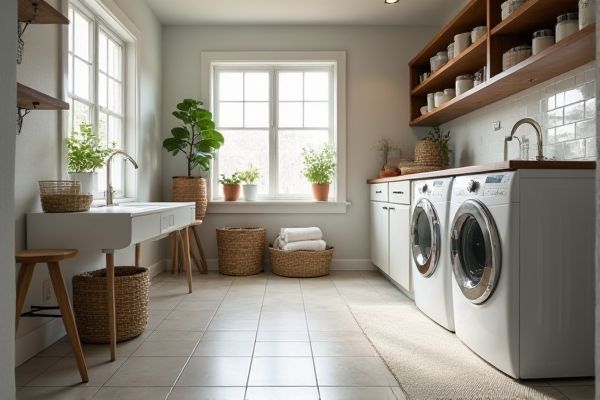
Tile flooring offers durability, water resistance, and a seamless look ideal for laundry rooms prone to moisture, while vinyl flooring provides a cost-effective, softer, and easier-to-install alternative with impressive water resistance and variety in design. Explore the detailed comparison to determine which flooring option best suits your laundry room needs and style preferences.
Table of Comparison
| Feature | Tile Flooring | Vinyl Flooring |
|---|---|---|
| Durability | Highly durable, resistant to scratches and moisture | Moderately durable, prone to dents and scratches |
| Water Resistance | Excellent, ideal for wet laundry areas | Good, water-resistant but seams may allow moisture |
| Installation | Complex, requires professional skills | Easy, DIY-friendly with peel-and-stick options |
| Maintenance | Low maintenance, easy to clean | Low maintenance, requires gentle cleaning |
| Comfort | Hard and cold underfoot | Softer and warmer, more comfortable |
| Cost | Higher initial cost, long-term value | Lower upfront cost, may require replacement sooner |
| Appearance | Variety of styles, classic look | Wide range of designs, can mimic tile |
Introduction: Tile Flooring vs Vinyl Flooring in Laundry Rooms
Tile flooring in laundry rooms offers exceptional durability and water resistance, making it ideal for areas prone to moisture and heavy use. Vinyl flooring provides a cost-effective, softer surface with easy installation and a wide range of styles, including water-resistant options suitable for laundry environments. Both materials enhance functionality, but tile is preferred for longevity and hard wear, while vinyl offers comfort and design versatility.
Material Overview: Tile and Vinyl Flooring
Tile flooring in laundry rooms offers durability and resistance to water, made from natural stone or ceramic materials that withstand heavy moisture and frequent cleaning. Vinyl flooring provides a softer underfoot experience, crafted from synthetic materials including PVC, and is highly water-resistant with easier installation and maintenance. Choosing between tile and vinyl flooring for your laundry room depends on your preference for longevity, comfort, and budget considerations.
Durability and Longevity Comparison
Tile flooring in laundry rooms offers exceptional durability, resisting moisture, stains, and heavy foot traffic for decades without significant wear. Vinyl flooring provides good resilience and water resistance but typically has a shorter lifespan, often showing signs of peeling or discoloration after 10-15 years. Homeowners seeking long-term durability often prefer tile flooring due to its robust and maintenance-friendly nature.
Water and Moisture Resistance
Tile flooring offers superior water and moisture resistance due to its non-porous surface and durable grout lines, making it ideal for laundry rooms prone to spills and humidity. Vinyl flooring provides excellent moisture resistance as well, with its impermeable wear layer preventing water damage and mold growth. Your choice depends on balancing durability, cost, and ease of maintenance in managing water exposure in the laundry area.
Maintenance and Cleaning Requirements
Tile flooring in laundry rooms requires regular grout cleaning and occasional sealing to prevent mold and mildew buildup, especially in high-moisture environments. Vinyl flooring offers easier maintenance with simple sweeping and mopping, as its water-resistant surface resists stains and does not require sealing. Both options benefit from prompt spill cleanup to maintain durability and appearance over time.
Installation Process and Costs
Tile flooring installation in a laundry room involves precise subfloor preparation, cutting, and grouting, typically costing between $5 to $15 per square foot including labor and materials. Vinyl flooring offers a quicker, more straightforward installation with peel-and-stick or click-lock options, generally priced from $2 to $7 per square foot. Your choice impacts initial costs and installation time, with vinyl being more budget-friendly and tile providing durable, long-term value.
Comfort and Safety Underfoot
Tile flooring in laundry rooms offers durability but can feel cold and hard, reducing underfoot comfort and increasing slip risk when wet. Vinyl flooring provides a softer, warmer surface with better slip resistance, enhancing safety and comfort for prolonged standing. Choosing cushioned vinyl flooring with textured finishes further improves ergonomics and reduces fatigue during laundry tasks.
Style, Design, and Color Options
Tile flooring offers a wide range of style and design options, including natural stone, ceramic, and porcelain varieties, with diverse color palettes and intricate patterns that enhance laundry room aesthetics. Vinyl flooring provides flexible design options mimicking wood, stone, or tile, available in numerous colors and finishes, making it budget-friendly and easy to customize. Both materials accommodate modern and traditional styles, but tile's durability contrasts with vinyl's softer, more comfortable surface.
Environmental Impact and Sustainability
Tile flooring offers greater environmental benefits due to its durability and use of natural materials like clay and minerals, which are recyclable and have a longer lifecycle. Vinyl flooring, made from synthetic PVC and additives, poses challenges in terms of non-biodegradability and release of volatile organic compounds (VOCs) during production and disposal. Sustainable choices favor tile flooring in laundry rooms to reduce carbon footprint and promote recyclability while minimizing ecological harm.
Cost-Effectiveness and Value for Laundry Rooms
Tile flooring typically involves a higher initial investment due to material and installation costs but offers exceptional durability and long-term value in laundry rooms prone to moisture and heavy use. Vinyl flooring is more cost-effective upfront, providing water resistance and ease of maintenance at a lower price point but may require replacement sooner due to wear. Balancing budget with durability needs, tile flooring often delivers better long-term savings and enhanced resale value in laundry rooms compared to vinyl.
 homyna.com
homyna.com